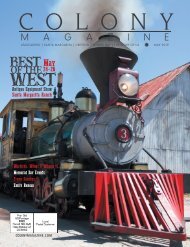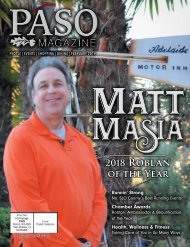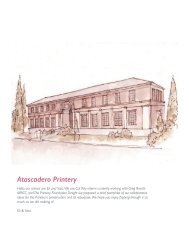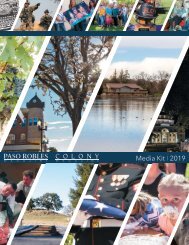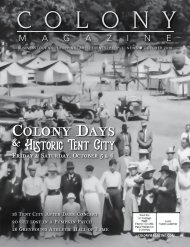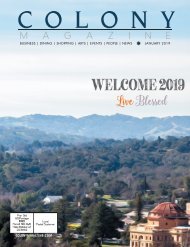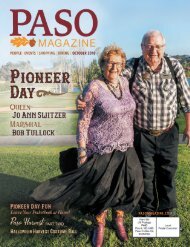2015 February PASO Magazine
Create successful ePaper yourself
Turn your PDF publications into a flip-book with our unique Google optimized e-Paper software.
Where are<br />
we going in<br />
– <strong>2015</strong>? –<br />
By Paso Robles<br />
City Manager<br />
Jim App<br />
In the Spring of<br />
2013, as the economy<br />
began to stabilize, the<br />
City Council established three recovery<br />
goals: enhance public safety;<br />
begin restoring maintenance services;<br />
and, further economic development.<br />
Given the depth of cutbacks<br />
necessitated by the recession,<br />
coupled with rising costs and a very<br />
modest, slow moving “recovery,”<br />
much remains to be done.<br />
The recession claimed 35% of the<br />
City workforce – and with them the<br />
capacity to provide the normal array<br />
of public services. The bleeding<br />
has stopped. In the Police Department,<br />
a couple of vacant positions<br />
have been filled so patrol operations<br />
now provide broad basic service on<br />
all shifts, and a special enforcement<br />
team is again combating drugs and<br />
the gangs. Similarly, basic public<br />
facility maintenance is coagulating<br />
with the filling of a number of vacant<br />
staff positions, along with new<br />
supplemental tax revenue for road<br />
maintenance.<br />
But, today it would cost more<br />
than $6 million per year to replace<br />
all the lost staff and the services<br />
they provided, with an additional<br />
$4 million needed to complete<br />
public facility repairs (other than<br />
roads) that were deferred due to the<br />
recession. Only $1 million per year<br />
is forecast (in excess of expenses).<br />
So, the million dollar question<br />
is, what is most important? Do<br />
I asked several community leaders to<br />
give me their thoughts, from their unique<br />
perspectives, on where we are going as a<br />
City and as a County in the new year.<br />
Last month we heard from newly<br />
elected Mayor Steven W. Martin, the<br />
new President of the Paso Robles<br />
Association of Realtors Cody Wilcoxson,<br />
and Part 1 of my interview with newly<br />
hired Superintendent of Schools Chris<br />
Williams.<br />
This month, we’ll get new year perspectives<br />
from Supervisor Frank Mecham,<br />
Paso Robles City Manager Jim App, and<br />
more from Williams.<br />
...Bob Chute<br />
What to expect in the new year<br />
TO THE FUTURE, AND BEYOND!<br />
we spend even more on roads,<br />
or repair parks, or add back<br />
more police, or paramedics, or<br />
do we reopen Centennial pool?<br />
Or, do we protect investments<br />
in public facilities by attending<br />
to deferred maintenance?<br />
These are the questions the City<br />
Council will debate this Spring<br />
(when they convene their next<br />
biennial goal setting).<br />
On the economic front, significant<br />
new investment in hotels and<br />
attractions are being made, Paso<br />
Robles was named the 2014 international<br />
wine region of the year, and<br />
core industrial companies are growing.<br />
The High School is completing<br />
new academic facilities, and Cuesta<br />
College gained voter approval to<br />
repair and replace obsolete North<br />
County campus buildings. These<br />
facilities are central to increasing<br />
education and training for the community’s<br />
labor force.<br />
An educated and well trained<br />
labor force is the foundation for<br />
growing industry and commerce.<br />
But what else is important to increase<br />
private business investment<br />
and spur job growth? Certainly,<br />
support for established businesses<br />
is vital; fortunately it can be provided<br />
by organizations like the<br />
Chamber of Commerce, Main<br />
Street, Economic Vitality Corporation,<br />
and the Paso Robles Wine<br />
Country Alliance. Attraction of<br />
new businesses is also important.<br />
Our history suggests that private<br />
investors and business owners<br />
were attracted to the Paso Robles<br />
lifestyle, and once hooked on the<br />
appeal of the Paso Robles area,<br />
they invested…building businesses<br />
and creating jobs. This<br />
continues to be the most promising<br />
path to business attraction.<br />
Preservation, enhancement and<br />
promotion of the Paso Robles<br />
lifestyle are, therefore, key to<br />
growing new business and jobs.<br />
How? By show-casing our setting,<br />
natural assets, and agriculture.<br />
Wine, olive oil, artisan food<br />
production, and dining - all attract<br />
interest and visitors. And, by taking<br />
care that built places are of good<br />
design and quality, and are well<br />
maintained – from streets to public<br />
parks, to buildings and neighborhoods,<br />
visitors, once in the area, will<br />
get hooked. And over time, they<br />
will invest (as have many others).<br />
It will be economic growth built on<br />
an appreciation for the unique place<br />
that is Paso Robles.<br />
Above and beyond the continuing<br />
work to recover services and intensify<br />
economic activity, considerable<br />
energy must be spent to address<br />
concerns about the sustainability of<br />
the Paso Robles Groundwater Basin.<br />
This issue will involve complex<br />
technical, legal and financial questions,<br />
as well as close cooperation<br />
with many, many stake holders, each<br />
with differing perspectives.<br />
The basic question is “will there<br />
be enough water, year in and year<br />
out, for all to grow and thrive as<br />
in the past?” Recent studies suggest<br />
the groundwater basin is being<br />
pumped more than it can replenish<br />
each year. And while its deeper<br />
aqueous layers “hold” considerable<br />
water, and big rain years can recharge<br />
it, recurring and protracted<br />
droughts coupled with increasing<br />
demands can impact access to the<br />
more accessible (shallower) water<br />
(in some areas). This has the attention<br />
of farmers and rural residents<br />
that rely on groundwater. The City<br />
too is alert as we use groundwater<br />
basin water to supply residences<br />
and businesses.<br />
In summary, when faced with<br />
complex choices, people can prioritize<br />
their needs, cooperate to moderate<br />
use and/or look for more (of<br />
whatever is in short supply). Such is<br />
the challenge ahead - finding ways<br />
to balance demands and increase<br />
resources. The ways are varied; the<br />
tricky part is that opinions about<br />
each vary even more.<br />
<strong>2015</strong> will be a year for such<br />
choices. The community’s capacity<br />
to invigorate investment, economic<br />
activity, and recovery depends on it.<br />
20 Paso Robles <strong>Magazine</strong>, <strong>February</strong> <strong>2015</strong>






